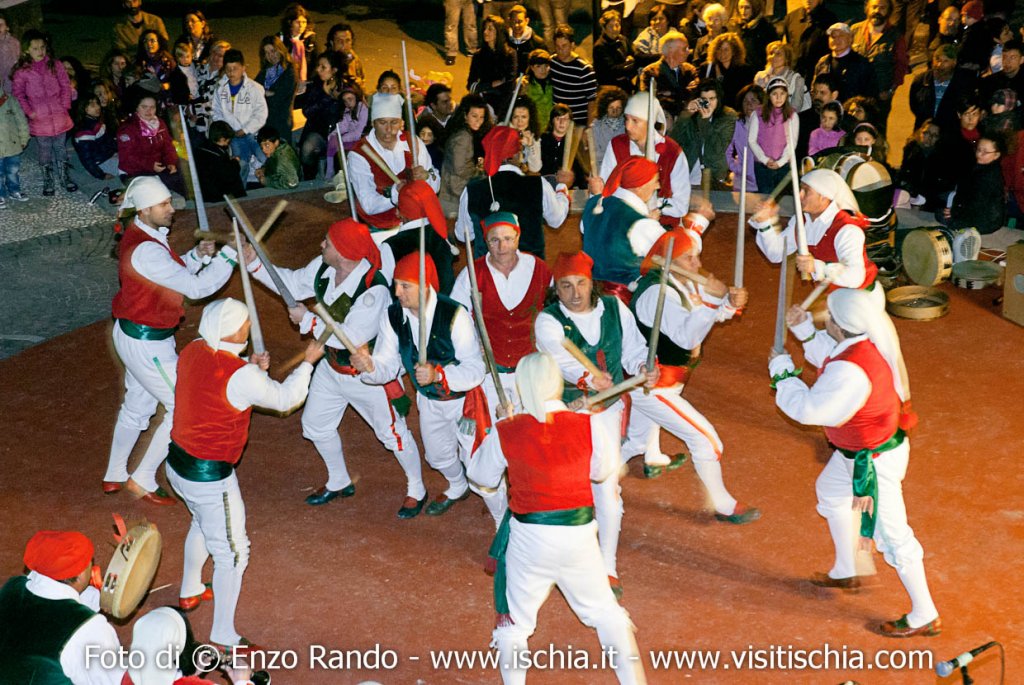The ‘Ndrezzata’ of Buonopane on Easter Monday

The ‘ndrezzata’ of Buonopane, on Easter Monday
The following conflict involved in it people of the two districts, Buonopane and Barano. After bloody conflicts, the peace was established at the foot of the Madonna della Porta statue, in the church of San Giovanni Battista, on Easter Monday. Since this moment, on Easter Monday and on June 24th this popular dance is dedicated to the patron San Giovanni Battista.
The folklore is made in Ischia with its dances
“A mascarata”, “Ndrizzata” e “A vattute e ll’astreche” were folkloristic dances tied to some events of the communities of Ischia, now become folk dances thanks to the creation of specialized groups.
According to some sources, “A mascarata” has Greek origins, according to others sources has Spanish origins, because the performances occurred on Easter Monday, or the Feast of St. John, the patron saint of Buonopane.
There are several hypotheses concerning the genesis of the dance. What combines myth and legend, concerns that the dance has its roots in 1500 in a feud between the inhabitants of Buonopane and Barano. The manuscript, discovered in the sacristy of the Church of St. John the Baptist in Buonopane, attests the coming of the Bishop to appease the quarrel between the two populations, due to a girl. Since 1950, Easter Monday, in Buonopane, remembers this tradition.
Other sources, certainly more reliable, call the dance “ ‘Ndrizzata” and go back to the First World War. During this period a considerable number of people from Buonopane, driven by poverty, emigrated to the United States. In New York, a group of over one hundred and sixty people began to dance the ballet that was immediately suppressed by the U.S. authorities because considered as a subversive training pro-Communist group. This fact caused the immediate expulsion of the dancers, who once repatriated, returned to tradition by defining the dance “Mascara” for lack of an official costume, because they did not have the economic means to achieve it. Only in the 1930s, the first costume appeared, mainly made of simple textiles like female hemp, raw silk and wool, used for the clothes of fishermen in the XVII century.
In 1941, the group of that time, went to the Royal Palace of Caserta. The exhibition was delineated in the work by Maria Bianca Galante, published in 1943 by the University of Rome where dance, costume and the disposition of the dancers were described in detail.
During the 1950s the ballet became a combination of different dances on the island, taking the name of “ ‘Ndrezzata”, which is still performed by the “Folk Group Ndrezzata”. It was considered “Trallera” ’s daughter for the presence of the serenade of the hilltop village of Fontana, of the “ ‘Ndrezzata” in Campagnano for the sermon, of the “Intrecciata” of Forio for the fisherman costumes and “Mascara” of Buonopane for dancing. Even the costume changed radically with the use of velvet and of the Italian flag. The women were rigorously excluded. Only since 1983, thanks to the birth of “Little ‘Ndrezzata” it was possible to dance the ballet again among mixed couples. With the birth of the “Scuola del Folklore”, in 1997, the popular culture, besmirched in the past, was re-discovered making the dance with the same costumes and the same structure that characterized the first half of twentieth-century.
‘A Vattute e ll’Astreche, instead, derives from the practice of building up, until the 1950s, the barrel-shaped or hemispherical domes roofs, called ‘a carusiello, from the Arab-Greek architectural culture. The houses built today with reinforced concrete, are often causes of unauthorized building and destruction stories. In the past they were built according to precise standard. The outline was prepared with a framework of chestnut poles on which were laid the “penicilli” (bundles of dried vines), which were covered with a layer of clay (clay or other lava material) and pumice stone (thin volcanic stones, but strong and compact). After this phase, the owner hoisted a flag early: it was the signal through which relatives, friends, neighbors and classmates were gathered. The whole country was involved in and happy to contribute to the final realization of the new dwelling. Those who attended, brought a strut, a pile of poplar with a larger part used to compress the lapillus wet by white quicklime, to make it waterproof. This effort lasted for three days, nonstop, time beaten by the beat men who sang, told stories and struck up nursery rhymes. Whoever could play an instrument, ran.
It began with a propitiatory song, Jesc sole, and the gossip of the country Nu sacce che succise a Murupane to follow. Since many people were homonyms, the head master gave the rhythm calling them by nickname. If drinking and eating were late, it was used to remembering the wickedness
by singing Tutti li miezziurn so'sunat. Then a few nursery rhymes for a toast. Following the anthem of the beat-men Sartulella and in conclusion the Tarantella lu Ceras. Once the roof was finished, it was used to throwing the grain, from time to time, to avoid the appearance of small cracks.
Meanwhile, many women delighted in preparing delicious meals. After the great feast, people started to dance tammurriate and tarantella (local dances), singing for a whole day. People were happy because another citizen had managed to build a roof and so the ‘nest’ where to start a family.


























